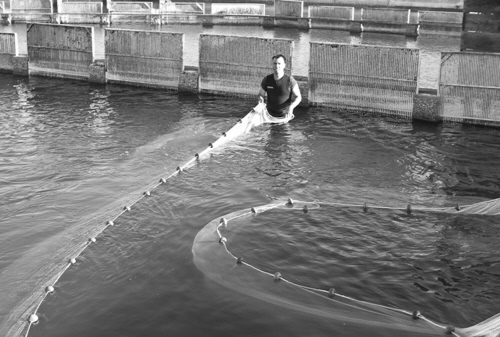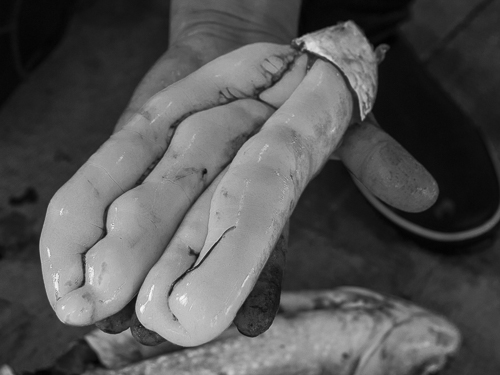This fishery is managed by the cooperative “Fishermen of Santa Giusta”.
Looking at a map of the surroundings of Oristano, we can distinguish the Gulf of Oristano to the west, with some canals and small lakes, but above all the lake of Cabras northwest of Oristano and the lake of Santa Giusta to the south. Man has inhabited this area for millennia leaving traces like the nuraghes and ancient tombs, but especially the ruins of the antique town of Tharros situated exactly at the extreme south of the Sinis peninsula. One of the reasons which have surely made man to settle in this area of Sardinia has to be the abundant marine life present in this region. In fact, until a few years ago the fishing around Oristano was the richest in Europe. Unfortunately, it has decreased markedly in the last years mainly because of industrialization and man-made changes to the coastline and the marine area bordering it.
Coming from Oristano and having passed some factories, we had to ask for directions in order to find the fishery called Pesaria. Having just arrived, we could see the canal of Pesaria, which was built in the 50s, between the Gulf of Oristano and the lake of Santa Giusta. The canal is crossed by a concrete bridge with a diverse set of openings facilitating the passing of fish from the sea to the lake. Fishing is done by using a handheld net, and by exploiting the direction of the current, the fish is forced to enter various underwater cages from which they are extracted. Even though modern fishing equipment is available, the fishermen capture fish not much different from how their grandfathers caught fish. From ancient times, man has known how to use ebb and flow to capture fish in the canal, and the same method is also used nowadays such that the fishermen of Santa Giusta are maintaining an ancient tradition.
The fish move from the sea to the lake at low tide and in the opposite direction at high tide letting the fish enter, but not exit different cages underwater. It was low tide when we arrived, and two fishermen were partially submerged in the canal. After having closed barriers across the canal, they were pulling both ends of a net against the current such that the net formed a semicircle. Then, they closed the openings of the net and pulled it towards the bridge where they emptied the fish in the net into a container. They also caught fish in a hand net, and both these means of fishing have been known for millennia.
Besides the methods mentioned above, Giuliano who was one of the fishermen, swam around the enclosed area in the canal wearing a diving mask. After a short time, he came back with a fish in his hand, which was rather surprising since fish underwater are slippery and difficult to hold. Having finished this activity, he started emptying an underwater cage of fish. Using the hand net, he gave it to another fisherman who poured the fish into a rowboat.
Having finished the fishing, the roe of some flathead mullets were extracted and would later be divided among the fishermen of the cooperative and not sold since the quantity was so small. The other fish would, after having been sorted, be freighted in refrigerated truck to the consumers.
According to the fishermen, the most numerous species they are catching are the following: mullet, bream, sole, sargo and occasionally also cuttlefish, octopus, eel, mussels, crabs and mollusks. We also got a short lesson on how to see if a fish is fresh or not. Above all, one has to look inside the gills and verify that they are red, which means that the fish is fresh. Then, have a look at the eyes because a veil will form across them the second day after capture, indicating that the fish is no longer fresh. Besides, it is necessary to ascertain that the colour gradations of its skin are vivid which shows that the fish s fresh.
As described above and as confirmed by the fishermen of Pesaria, fish have become far less abundant than in the past in this area. However, work is being done in collaboration with biologists at the university of Sassari in order to improve salinity and amount of oxygen in the lakes.
A video from “I pescatori di Santa Giusta”.


